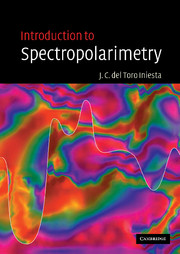Book contents
- Frontmatter
- Contents
- Preface
- Acknowledgements
- 1 Historical introduction
- 2 A review of some basic concepts
- 3 The polarization properties of quasi-monochromatic light
- 4 Linear optical systems acting on polarized light
- 5 Solar polarimetry
- 6 Absorption and dispersion
- 7 The radiative transfer equation
- 8 The RTE in the presence of a magnetic field
- 9 Solving the radiative transfer equation
- 10 Stokes spectrum diagnostics
- 11 Inversion of the RTE
- Index
5 - Solar polarimetry
Published online by Cambridge University Press: 11 August 2009
- Frontmatter
- Contents
- Preface
- Acknowledgements
- 1 Historical introduction
- 2 A review of some basic concepts
- 3 The polarization properties of quasi-monochromatic light
- 4 Linear optical systems acting on polarized light
- 5 Solar polarimetry
- 6 Absorption and dispersion
- 7 The radiative transfer equation
- 8 The RTE in the presence of a magnetic field
- 9 Solving the radiative transfer equation
- 10 Stokes spectrum diagnostics
- 11 Inversion of the RTE
- Index
Summary
If it were not for its magnetic field, the Sun would be as dull a star as most astronomers think it is.
—R. Leighton, 1965.Polarimetric accuracy is one of the most important goals of modern astronomy. The definition itself of polarimetric accuracy, however, is difficult since we mostly measure polarization differences and are uncertain in establishing the zero level, which is often set by convention. Hence, by “accuracy” we shall understand the sensitivity to variations of the polarization level. Besides the greatest polarimetric accuracy, every astronomical observation should ideally pursue the highest spectral, spatial, and temporal resolution with the widest spatial and spectral coverage. However, all these goals are hard to accomplish at the same time and one always needs to compromise depending on the specific objectives a given observation is aimed at. The amount of available photons from the Sun is never sufficient. In fact, it is equal per resolution element to that from a scarcely resolved star of the same effective temperature. This observational fact is easy to understand (e.g., Mihalas, 1978) if one takes into account the invariance with distance of the specific intensity (energy per unit normal surface, per unit time, per unit frequency interval, per unit solid angle) and its proportionality to the photon distribution function (number of photons per unit volume, per unit frequency interval, per unit solid angle).
Solar polarimetry is, of course, a part of the game and has several limiting factors that govern the final accuracy of the measurements.
- Type
- Chapter
- Information
- Introduction to Spectropolarimetry , pp. 64 - 86Publisher: Cambridge University PressPrint publication year: 2003
- 1
- Cited by



